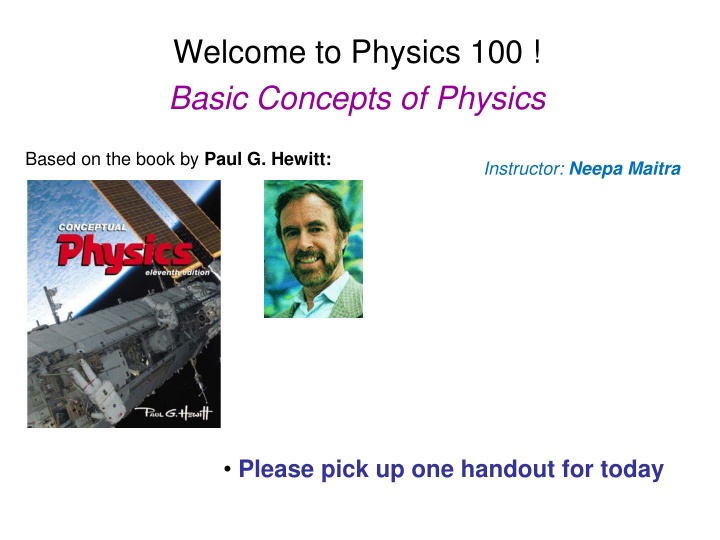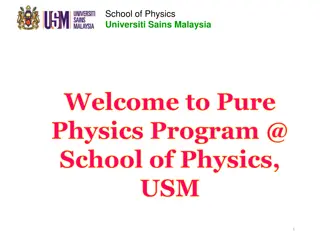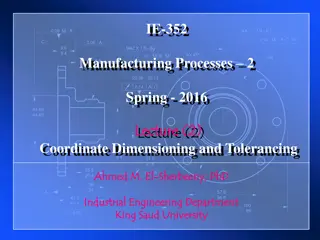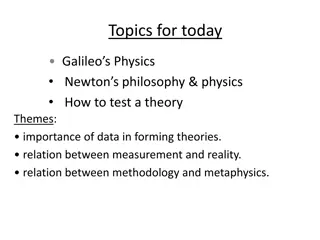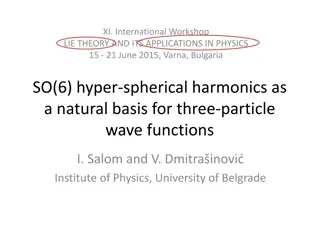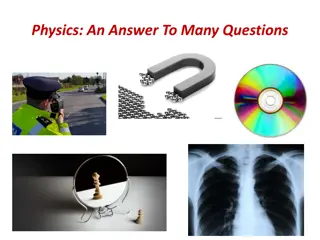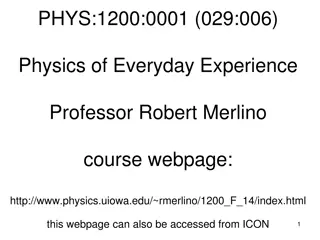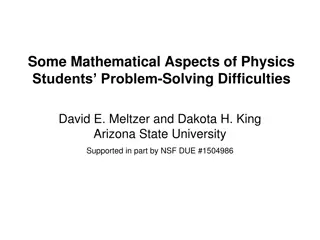Welcome to Physics 100! Basic Concepts of Physics
This physics course, led by Instructor Neepa Maitra, covers fundamental concepts of physics based on Paul G. Hewitt's book. It includes topics such as Newton's laws, momentum, energy, rotation, and more. The course structure, grading system, and important notes are outlined, along with details on classroom location, lecture times, and contact information. Students are encouraged to engage in discussions and activities, using clickers for participation. This one-semester terminal course is part of the Scientific World category of the Flexible Core and is a prerequisite for PHYS 101 lab-including course. The syllabus ranges from linear motion to quantum theory. Students are requested to provide personal information for the instructor. Academic integrity is emphasized, and acts of dishonesty are strictly dealt with. Overall, the course aims to provide a solid foundation in physics principles.
Download Presentation

Please find below an Image/Link to download the presentation.
The content on the website is provided AS IS for your information and personal use only. It may not be sold, licensed, or shared on other websites without obtaining consent from the author.If you encounter any issues during the download, it is possible that the publisher has removed the file from their server.
You are allowed to download the files provided on this website for personal or commercial use, subject to the condition that they are used lawfully. All files are the property of their respective owners.
The content on the website is provided AS IS for your information and personal use only. It may not be sold, licensed, or shared on other websites without obtaining consent from the author.
E N D
Presentation Transcript
Welcome to Physics 100 ! Basic Concepts of Physics Based on the book by Paul G. Hewitt: Instructor: Neepa Maitra Please pick up one handout for today
Course information (on your handout) Location: Room HW 511 Lecture Times: Tu and Fr: 2.10pm - 3.25pm Instructor: Neepa Maitra email: nmaitra@hunter.cuny.edu phone: 212-650-3518 office: 1214E HN Office hours: Tu and Fr: 12.00pm-1.00pm or, by appointment. Text:Conceptual Physics, 12th Edition, by Paul G. Hewitt (Pearson, Addison-Wesley, 2014). But 9th ,10th ,and 11th editions are also fine. Lectures posted on-line afterlecture: (but a pre-lecture will be posted here before class, see shortly) http://www.hunter.cuny.edu/physics/courses/physics100/fall-2016 Grading: Attendance/Participation Midterm Exams Final Exam 5% 50% 45% (2) Attendance/Participation: We will make use of clickers in this course (from second lecture onwards), and also have questions to discuss in class. Neepa will say more about these clickers on Tuesday. Midterms: Two mid-term in-class multiple-choice exams: Fri Sep 30 and Fri Nov 18. Final Exam: TBD, 11.30am 1.30pm, cumulative, all multiple-choice.
Important Note! This is a one-semesterterminal physics course, and it does not fulfill the pre-med physics requirement. Another note: PHYS 100 fulfills the Scientific World category of the Flexible Core of Pathways. It is a pre/co-requisite of the lab-including course PHYS 101, of the Life and Physical Sciences category (but you may take 100 without taking 101). Note from the Office of Student Services:
Book chapter Topic Syllabus: (on your handout) 2 Introduction/Newton s First Law Linear Motion 3 Newton's Second Law 4 5 Newton s Third Law Momentum 6 Energy 7 Rotation 8 Hunter College regards acts of academic dishonesty (e.g., plagiarism, cheating on examinations, obtaining unfair advantage, and falsification of records and official documents) as serious offenses against the values of intellectual honesty. The college is committed to enforcing the CUNY Policy on Academic Integrity and will pursue cases of academic dishonesty according to the Hunter College Academic Integrity Procedures. Gravity 9 The Atomic Nature of Matter 11 Liquids 13 Gases and Plasmas 14 Heat 15 Vibrations and Waves 19 Sound 20 Electrostatics 22 Electric current 23 Magnetism 24 Electromagnetic Induction 25 Properties of Light 26 Color 27 Introduction to Quantum Theory (31)
Info about you, for Neepa: On a piece of paper, please write down the following information and turn it at the end of class today. 1. Your name 2. Your email address 3. Your year in school (i.e. sophomore etc) 4. Your major (if known) 5. Any previous exposure (eg high school) to physics 6. Reasons for taking this course
Notes on Chapter 1: About Science We will barely cover this in class, and it will not be examined, but I encourage you to read it on your own. Main points: must be testable. Observable physical evidence is at the basis of science. Scientific theories of size of earth, moon, sun and try some at home!) Measurement plays a crucial role (eg. read about measurements in 200 s BC Mathematics provides unambiguous, compact language for science tested and verifiable hypotheses about certain aspects of the natural world. Theories may change in time! Terminology: Hypothesis = educated guess Law = principle = rule Theory = synthesis of body of info that encompasses well- Beware of pseudoscience! Lacks evidence and falsifiability test.
Chapter 2: Newtons First Law of Motion - Inertia Before getting into this, note ideas on motion prior to Newton (I won t examine this) object, or to violent influences (push or pull) . Normal state = at rest, except for celestial bodies. Heavier objects fall faster, striving harder to achieve their proper place . Aristotle(c. 320 BC), all motions are due to nature of the around earth. Formulated sun-centered system. -- Copernicus(c. 1500 s) doubted that everything revolved also with Aristotle s natural state idea, using observation and experiment. Dropped objects from Leaning Tower of Pisa and found they fell at the same rate (apart from small effect of air resistance). Inclined planes experiments. Concept of Inertia -- Galileo(c. 1600 s) agreed with Copernicus, and disagreed Read more in your book. -- Newton(c. 1665) formulated Newton s Laws of Motion
Newtons 1st Law of Motion: Inertia Every object continues in its state of rest, or of uniform motion in a straight line, unless acted on by a force. Eg1: Table here, at rest. If it started moving, we d look for what caused the motion (force) Eg2: Tablecloth trick (or, here, keys-on-paper-on-table trick ). If I whip out the paper from under the keys, the keys stay fixed continuing in state of rest. Eg3: Ball at rest. Give a push (force) it starts to roll (changes state of motion). When you let go, it continues to roll, even with no force on it continuing in its state of motion. Eg4: Riding on the subway, you have to hang on to the pole to stop continuing forward after the subway stops
Newtons 1st Law of Motion: Inertia Every object continues in its state of rest, or of uniform motion in a straight line, unless acted on by a force. Inertia = property of objects to resist changes in motion Heavier (more massive) objects tend to have more inertia (more in next chapter) e.g. takes more work to shake flagpole back and forth than to shake a feather
Force = something that produces a change in motion, a push or a pull. Source can be muscle effort, or gravitational, or electric, or magnetic Often wedenote force by F A common force is weight = force due to gravity on an object (more detail in later lectures) Newton, N= standard unit of force. Physicists equivalent of pounds , but not the same numerically i.e. 1-lb = 4.448-N. Eg. 1-kg weighs 9.8-N and 2.2-lb. Net force = resultant force when several forces are acting Eg: Note that any force has a direction!
Equilibrium Equilibrium is when the net force on something is zero Mathematically F = 0 An object in equilibrium remains at rest or remains in uniform straight-line motion (from Newton s 1st law) Eg. 2-lb bag of sugar hanging on a weighing scale 2 There are 2 forces on the bag: (1)gravitational force downwards towards earth (= 2-lb, or 9-N down) 1 (2)tension force upwards from stretched spring (= 2-lb, or 9-N up) -- equal and opposite, so no net force, and bag remains at rest.
Question The staging shown weighs 300 N and supports two painters, one 250 N and the other 300 N. The reading on the left scale is 400 N. what is the reading on the right-hand scale? A)300 N B) 400 N C) 450 N D)850 N E) None of the above
Answer The staging shown weighs 300 N and supports two painters, one 250 N and the other 300 N. The reading on the left scale is 400 N. what is the reading on the right-hand scale? A) 300 N B) 400 N C) 450 N D) 850 N E) None of the above The upward forces are (400 N + RH tension). By the equilibrium rule F = 0, this upward total must equal the downward forces are (250 N + 300 N + 300 N) = 850 N. Hence, RH tension must be 450 N. Note that although the two tensions must add to the total weight, the tension is larger in the rope nearer the heavier person.
Support Force (a.k.a. Normal Force) What forces are acting on the book lying on the table? Gravity (weight of book) acts downward. But since book is at rest, there must be an equal upward force. This upward force is called the support force, or normal force, and equals the weight of the book. F = 0, since at rest What creates the normal force? The atoms in the table behave like tiny springs, so push back on anything (eg book) trying to compress them.
Question Say a 120-lb person steps on some bathroom scales. (i) How much is gravity pulling on her ? 120-lb (=weight) (ii) What is the net force on her? 0 (since she s at rest) (iii) Now suppose she stands on two bathroom scales, with weight evenly divided between them. What will each scale read? 60 lb each, since the sum of the scale readings must balance the weight.
Clicker Question Consider again the 120-lb person who steps on the bathroom scales. What is the net force on the bathroom scales? A)0 B)120-lb C)120 N D)None of the above
Answer Consider again the 120-lb person who steps on some bathroom scales. What is the net force on the bathroom scales? Because the scales are at rest . A) 0 B) 120-lb There are two forces on the scales: the downward weight of the person, exactly balanced by the support force from the floor. C) 120 N D) None of the above
Equilibrium of Moving Things An object moving at constant speed in a straight line is also in equilibrium, F = 0. Question: Can any object on which only one force is acting, be in equilibrium? No! Consider pushing a box across a floor. (1) What forces are acting on the box? Weight downward, support force upward, your push across, and friction between the floor and the box opposing your push. (2) What can you say about the relative magnitudes of the forces if is moving with unchanging speed across the floor ? Magnitude of weight = support force. Your push = friction, if speed unchanging. (If it is speeding up, then your push > friction.)
Question In which situation is the object in equilibrium? A) A train accelerating along a track B) A cart rolling on the floor and slowing down. C) A man cycling down a straight road at constant speed. D) A man on a bike going faster and faster downhill on a straight road without pedaling. E) An object can only be in equilibrium if it is completely at rest. Answer: C Equilibrium means all forces balance, i.e. add to zero, i.e. zero net force on the object. Then, an object at rest remains at rest, or an object moving at constant speed in a straight line keeps going at constant speed in the same straight line. There are forces acting on the man going at constant speed, but they must cancel to zero since otherwise he would be changing his speed
Another Question If no external forces are acting on a moving object it will A) move slower and slower until it finally stops. B) continue moving at the same speed in the same direction C) continue moving at the same speed but may change direction D) But it can t be moving at all if there no forces acting on it. Answer: B
The moving Earth Earth is moving around the sun at 30 km/sec. So, if I stand near a wall, and jump up in the air for a few seconds, why doesn t the wall slam into me?? Because of inertia. While standing on the ground, I am moving along with the earth at 30 km/s, and when I jump, I (and the air) continue moving (sideways) at 30 km/s.
Clicker Question When the pellet fired into the spiral tube emerges, which path will it follow? (Neglect gravity).
Answer When the pellet fired into the spiral tube emerges, which path will it follow? (Neglect gravity). B: While in the tube, the pellet is forced to curve, but when it gets outside, no force is exerted on the pellet and (law of inertia) it follows a straight-line path hence, B.
Clicker Question When the ball at the end of the string swings to its lowest point, the string is cut by a sharp razor. What path will the ball then follow?
Answer When the ball at the end of the string swings to its lowest point, the string is cut by a sharp razor. What path will the ball then follow? b) At the moment the string is cut, the ball is moving horizontally. After the string is cut, there are no horizontal forces, so the ball continues horizontally at constant speed. But there is the force of gravity which causes the ball to accelerate downward, so the ball gains speed in the downward direction. The combination of constant horiz. speed and downward gain in speed produces the curved (parabolic) path..
